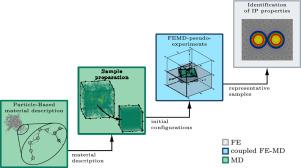International Journal of Mechanical Sciences ( IF 7.3 ) Pub Date : 2021-06-06 , DOI: 10.1016/j.ijmecsci.2021.106564 Maximilian Ries , Gunnar Possart , Paul Steinmann , Sebastian Pfaller

|
This contribution introduces an unconventional procedure to characterize spatial profiles of elastic and inelastic properties inside polymer interphases around nanoparticles. Interphases denote those regions in the polymer matrix whose mechanical properties are influenced by the filler surfaces and thus deviate from the bulk properties. They are of particular relevance in case of nano-sized filler particles with a comparatively large surface-to-volume ratio and hence can explain the frequent observation that the overall properties of polymer nanocomposites cannot be determined by classical mixing rules, which only consider the behavior of the individual constituents.
Interphase characterization for nanocomposites poses hardly solvable challenges to the experimenter and is still an unsolved problem in many cases. Instead of real experiments, we perform pseudo experiments using our recently developed Capriccio method, which is an MD-FE domain-decomposition tool specifically designed for amorphous polymers. These pseudo-experimental data then serve as input for a typical inverse parameter identification. With this procedure, spatially varying mechanical properties inside the polymer are, for the first time, translated into intuitively understandable profiles of continuum mechanical parameters.
As a model material, we employ silica-enforced polystyrene, for which our procedure reveals exponential saturation profiles for Young’s modulus and the yield stress inside the interphase, where the former takes about seven times the bulk value at the particle surface and the latter roughly triples. Interestingly, hardening coefficient and Poisson’s ratio of the polymer remain nearly constant inside the interphase. Besides gaining insight into the constitutive influence of filler particles, these unexpected and intriguing results also offer interesting explanatory options for the failure behavior of polymer nanocomposites.
中文翻译:

表征聚合物纳米复合材料中机械界面的耦合 MD-FE 方法
这一贡献引入了一种非常规程序来表征纳米粒子周围聚合物界面内的弹性和非弹性特性的空间分布。中间相表示聚合物基体中的那些区域,其机械性能受填料表面的影响,因此偏离整体性能。它们在具有相对较大表面积与体积比的纳米级填料颗粒的情况下特别相关,因此可以解释经常观察到的聚合物纳米复合材料的整体性能不能由经典混合规则确定,经典混合规则只考虑行为个别组成部分。
纳米复合材料的界面表征给实验者带来了难以解决的挑战,并且在许多情况下仍然是一个未解决的问题。我们没有使用真正的实验,而是使用我们最近开发的 Capriccio 方法进行伪实验,这是一种专为无定形聚合物设计的 MD-FE 域分解工具。这些伪实验数据然后用作典型逆参数识别的输入。通过这个过程,聚合物内部空间变化的机械性能第一次被转化为连续机械参数的直观可理解的轮廓。
作为模型材料,我们采用二氧化硅强化聚苯乙烯,为此我们的程序揭示了杨氏模量的指数饱和曲线和界面内的屈服应力,其中前者大约是颗粒表面体积值的七倍,而后者大约是三倍. 有趣的是,聚合物的硬化系数和泊松比在界面内几乎保持不变。除了深入了解填料颗粒的本构影响之外,这些意外和有趣的结果还为聚合物纳米复合材料的失效行为提供了有趣的解释选项。


























 京公网安备 11010802027423号
京公网安备 11010802027423号